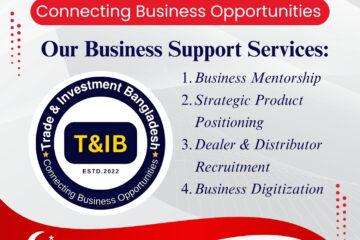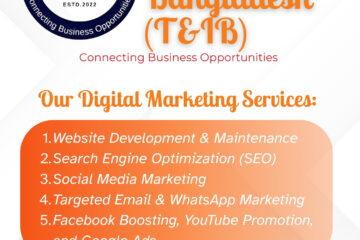The Art of Buyer-Seller Matchmaking
Md. Joynal Abdin*
Business Consultant & Digital Marketer
Co-Founder & CEO of Trade & Investment Bangladesh
Buyer-seller matchmaking holds immense significance in the business landscape, acting as a strategic cornerstone that facilitates mutually beneficial relationships between businesses. The following points highlight its key importance:
Optimized Resource Utilization: Buyer-seller matchmaking enables businesses to optimize their resources by connecting with partners that complement their strengths and fill gaps in their capabilities. This strategic alignment helps in efficient resource utilization.
Market Expansion and Reach: Forming alliances with the right buyers or sellers allows businesses to expand their market reach. This can be especially crucial for entering new geographic regions or tapping into diverse customer segments.
Enhanced Innovation and Collaboration: Collaborative partnerships foster innovation through the exchange of ideas, technologies, and expertise. By aligning with compatible counterparts, businesses can stay at the forefront of industry trends and technological advancements.
Risk Mitigation: Buyer-seller matchmaking can help mitigate risks associated with market fluctuations, economic uncertainties, or industry challenges. Diversifying partnerships spreads risk and creates a more resilient business ecosystem.
Increased Competitiveness: Strategic alliances enhance the competitiveness of businesses by allowing them to offer more comprehensive solutions, products, or services. This competitive edge can be vital in crowded markets.
Cost Savings: Collaborative efforts often result in cost savings through economies of scale, joint procurement, or shared infrastructure. This can contribute significantly to improving overall business profitability.
Adaptation to Market Dynamics: The business landscape is dynamic, and buyer-seller matchmaking helps companies adapt to changing market conditions. Through flexible partnerships, businesses can quickly respond to evolving customer needs and industry trends.
Customer-Centric Approach: Building partnerships with businesses that share similar values and priorities helps in creating a more customer-centric approach. This alignment enhances the overall customer experience and satisfaction.
Access to New Capabilities: Businesses can gain access to new capabilities, technologies, or skills through partnerships with the right buyers or sellers. This access can accelerate growth and foster a culture of continuous improvement.
Long-Term Sustainability: Establishing enduring relationships through buyer-seller matchmaking contributes to the long-term sustainability of businesses. These partnerships create a foundation for mutual growth and resilience in the face of challenges.
In summary, buyer-seller matchmaking is not merely a transactional process but a strategic imperative that empowers businesses to thrive in a dynamic and competitive environment by fostering collaboration, innovation, and sustained growth.
-
Understanding Buyer-Seller Dynamics:
The dynamics between buyers and sellers in the business world are complex and multifaceted, encompassing a range of interactions, negotiations, and relationships. Understanding these dynamics is crucial for businesses to navigate the marketplace effectively. Here are key aspects of the dynamics between buyers and sellers:
- Interdependence: Buyers and sellers are inherently interdependent. Buyers seek products or services to fulfill their needs, while sellers rely on buyers to purchase their offerings. This interdependence forms the basis of the economic exchange that drives business transactions.
- Information Asymmetry: Information is a critical element in the buyer-seller relationship. However, there is often an information asymmetry, where one party may have more information than the other. This can create challenges in negotiations and decision-making.
- Power Dynamics: The balance of power between buyers and sellers can shift based on various factors such as market conditions, the uniqueness of the product or service, and the availability of alternatives. Understanding and navigating these power dynamics is essential for successful transactions.
- Relationship Building: Building strong relationships is key to long-term success for both buyers and sellers. Trust and communication play crucial roles in fostering positive relationships that extend beyond individual transactions.
- Negotiation Strategies: Negotiation is a fundamental aspect of the buyer-seller dynamic. Both parties engage in negotiations to secure the best terms, pricing, and conditions. Negotiation strategies may vary based on factors such as market competition and the nature of the product or service.
- Evolving Consumer Behavior: Changes in consumer behavior influence the dynamics between buyers and sellers. With the rise of digital technologies, consumers often conduct thorough research before making a purchase, altering the traditional roles of information dissemination and decision-making.
- Globalization: In a globalized economy, buyers and sellers may operate across borders. This introduces additional complexities related to cultural differences, regulatory considerations, and logistical challenges.
- Technology Impact: Technological advancements have transformed the buyer-seller relationship. E-commerce, online marketplaces, and digital communication tools have altered the way transactions occur, providing new channels for engagement.
- Customization and Personalization: Buyers increasingly seek personalized and customized offerings. Sellers need to understand and respond to individual buyer preferences, leading to a more tailored and customer-centric approach.
- Post-Sale Interaction: The relationship between buyers and sellers doesn’t end with a sale. Post-sale interactions, including customer support, service, and feedback loops, are critical for maintaining customer satisfaction and loyalty.
- Sustainability and Ethical Considerations: Buyers are placing greater importance on sustainability and ethical business practices. Sellers need to align with these values to meet the evolving expectations of socially conscious consumers.
Understanding and adapting to these dynamics is essential for businesses to navigate the complexities of the buyer-seller relationship successfully. It requires a strategic and customer-centric approach that goes beyond transactional interactions and focuses on building enduring partnerships.
-
The Evolution of Buyer-Seller Matchmaking:
As the business landscape continues to evolve, buyer-seller matchmaking is also undergoing transformations driven by emerging trends and innovations. These developments aim to enhance efficiency, foster better connections, and adapt to changing market dynamics. Here are some emerging trends in the field of buyer-seller matchmaking:
AI and Predictive Analytics: Artificial Intelligence (AI) and predictive analytics are being increasingly used to analyze vast amounts of data to identify potential matches between buyers and sellers. These technologies enable more accurate predictions of compatibility based on historical data, behavior patterns, and market trends.
Blockchain for Transparency and Trust: Blockchain technology is gaining traction in buyer-seller matchmaking to enhance transparency and trust in transactions. Smart contracts and decentralized ledgers can streamline processes, reduce fraud, and provide a secure and transparent platform for transactions.
Advanced Matching Algorithms: Innovations in matching algorithms are improving the precision of pairing buyers and sellers. These algorithms take into account a broader set of criteria, including behavioral data, preferences, and real-time market conditions, to create more accurate and dynamic matches.
Virtual and Augmented Reality (VR/AR): VR and AR technologies are being leveraged to enhance the virtual experience of buyer-seller interactions. Virtual showrooms, product simulations, and immersive experiences are becoming valuable tools for showcasing products and services in a more engaging manner.
Chatbots and Virtual Assistants: Chatbots and virtual assistants powered by natural language processing (NLP) are being integrated into matchmaking platforms. They facilitate real-time communication, answer queries, and guide users through the matchmaking process, enhancing user experience and accessibility.
Social Media Integration: Integration with social media platforms is becoming increasingly common in buyer-seller matchmaking. This allows for a more comprehensive understanding of the business profile and reputation of potential partners, as well as facilitating direct communication.
Ecosystem Collaboration Platforms: Platforms that bring together entire ecosystems of buyers and sellers are emerging. These platforms facilitate collaboration, networking, and partnerships among businesses within a specific industry or niche.
Data Privacy and Security Measures: With growing concerns about data privacy, buyer-seller matchmaking platforms are implementing robust security measures and compliance standards to ensure the protection of sensitive information and build trust among participants.
Subscription-Based Models: Some buyer-seller matchmaking platforms are adopting subscription-based models, providing businesses with ongoing access to a curated pool of potential partners. This model encourages long-term relationships and continuous engagement.
Sustainability and ESG Integration: As sustainability gains prominence, buyer-seller matchmaking platforms are incorporating Environmental, Social, and Governance (ESG) criteria into their matching algorithms. This allows businesses to align with partners who share similar values and sustainability goals.
Collaborative Intelligence Platforms: Platforms that leverage collaborative intelligence, combining the insights and expertise of multiple stakeholders, are emerging. These platforms foster a collaborative approach to problem-solving and decision-making in buyer-seller relationships.
Real-Time Feedback and Reviews: Real-time feedback mechanisms and review systems are becoming integral to buyer-seller matchmaking platforms. This feature allows participants to share their experiences, building credibility and helping others make informed decisions.
These emerging trends indicate a shift toward more sophisticated, data-driven, and user-centric approaches in buyer-seller matchmaking. Businesses that embrace these innovations can gain a competitive edge by forging strategic partnerships and adapting to the evolving needs of the market.
-
The Art of Identifying Ideal Matches:
Identifying compatible buyer-seller partnerships is a critical aspect of building successful and mutually beneficial business relationships. The criteria for determining compatibility can vary across industries and businesses, but several key factors are universally important. Here are criteria that businesses often consider when identifying compatible buyer-seller partnerships:
Strategic Alignment: Businesses seek partners with strategic alignment in terms of long-term goals, vision, and mission. Compatibility in strategic objectives ensures that both parties are working towards common outcomes and shared success.
- Complementary Capabilities: Compatible partnerships often involve businesses with complementary capabilities. This could include expertise, resources, technology, or skills that complement and enhance each other, leading to a more comprehensive and competitive offering.
- Cultural Fit: Cultural fit is crucial for long-term collaboration. Businesses look for partners whose values, ethics, and corporate culture align with their own. A shared cultural foundation can contribute to smoother communication and collaboration.
- Financial Stability: Financial stability is a key criterion for identifying compatible partnerships. Businesses want to work with partners who are financially healthy and have a track record of fiscal responsibility. This helps mitigate risks and ensures the sustainability of the partnership.
- Market Knowledge and Expertise: Compatibility often hinges on the market knowledge and expertise that each party brings to the partnership. Businesses look for partners who understand the industry, market trends, and customer needs, bringing valuable insights to the collaboration.
- Innovation and Adaptability: In rapidly changing business environments, adaptability and innovation are essential. Compatible partners are those that demonstrate a commitment to innovation, a willingness to adapt to market dynamics, and the ability to stay ahead of industry trends.
- Communication and Trust: Effective communication and trust are foundational for any successful partnership. Businesses seek partners with open and transparent communication styles, fostering trust and ensuring a healthy working relationship.
- Geographic and Market Presence: Compatibility can be influenced by geographic and market presence. Partnerships with businesses that have a strong presence in specific regions or markets can provide strategic advantages and access to a broader customer base.
- Regulatory Compliance: Businesses must ensure that potential partners adhere to relevant regulations and compliance standards. Regulatory alignment is crucial to avoid legal issues and ensure ethical business practices.
- Flexibility in Relationship Dynamics: Compatible partnerships involve a level of flexibility in how the relationship evolves. Businesses look for partners who are open to adapting to changing circumstances, accommodating growth, and addressing challenges collaboratively.
- Shared Customer Focus: Partnerships that prioritize a customer-centric approach tend to be more successful. Businesses seek partners who share a commitment to delivering value to customers and enhancing the overall customer experience.
- Risk Tolerance and Management: Assessing risk tolerance and management strategies is vital. Compatible partners should have similar attitudes toward risk, and there should be a clear understanding of how risks will be identified, assessed, and managed throughout the partnership.
- Mutual Respect and Integrity: Mutual respect and integrity form the basis of a strong partnership. Businesses seek partners with a reputation for ethical conduct, professionalism, and a commitment to upholding shared values.
By carefully evaluating these criteria, businesses can identify partners with whom they are more likely to establish a compatible, collaborative, and enduring relationship, ultimately leading to mutual success in the marketplace.
-
Navigating the Benefits of Matchmaking:
Forming strategic alliances between buyers and sellers can offer a myriad of advantages for both parties involved. These alliances go beyond transactional relationships, fostering long-term partnerships that contribute to the growth and success of each participant. Here are various advantages for both buyers and sellers in forming strategic alliances:
5.1 Advantages for Buyers:
- Cost Savings: Buyers can benefit from cost savings through economies of scale and joint procurement. Strategic alliances allow for bulk purchasing and shared resources, reducing overall procurement costs.
- Access to Expertise: Strategic alliances provide buyers with access to the expertise, knowledge, and specialized skills of their partners. This access can be particularly valuable when entering new markets or industries.
- Risk Mitigation: Buyers can mitigate risks associated with market uncertainties, supply chain disruptions, and other challenges by forming strategic alliances. Diversifying sources and collaborating with reliable partners enhances resilience.
- Innovation and Product Development: Collaboration with sellers brings innovation and accelerates product development. Buyers can leverage the seller’s capabilities, technologies, and R&D efforts to stay competitive and meet evolving customer demands.
- Market Expansion: Buyers can expand their market reach by forming strategic alliances with sellers that have a strong presence in different regions. This expansion enables access to new customer segments and opportunities.
- Improved Negotiation Power: Strategic alliances can enhance the negotiation power of buyers. As part of a larger network or consortium, buyers may negotiate better terms, pricing, and conditions with sellers.
- Shared Marketing and Promotion: Collaborative marketing efforts between buyers and sellers in strategic alliances can result in shared promotional activities. This joint approach can increase brand visibility and market penetration.
- Operational Efficiency: Buyers can achieve operational efficiency by aligning processes with their strategic alliance partners. Streamlined operations and shared resources contribute to cost-effectiveness and overall business agility.
- Access to New Technologies: Buyers can gain access to new and advanced technologies through strategic alliances. This access is particularly beneficial when dealing with sellers at the forefront of technological innovation.
To read 2nd part of this article, click here!
The Art of Buyer-Seller Matchmaking
Mr. Md. Joynal Abdin is a Business Consultant & Digital Marketer based in Dhaka, Bangladesh. He is Founder & CEO, Trade & Investment Bangladesh and Co-Founder & CEO of Bangladesh Trade Center. Previously he served at Dhaka Chamber of Commerce & Industry (DCCI) as Executive Secretary; DCCI Business Institute (DBI) as Executive Director; SME Foundation as Deputy Manager; and the Federation of Bangladesh Chambers of Commerce & Industry (FBCCI) as Assistant Secretary.
The list of services Mr. Abdin is offering includes but not limited to Business Mentorship, Business Research and Documentations, Export Market Selection and Product Positioning at Home and Abroad; Buyers-Sellers Matchmaking; Website Development; Search Engine Optimization (SEO); and Social Media Marketing etc.






0 Comments